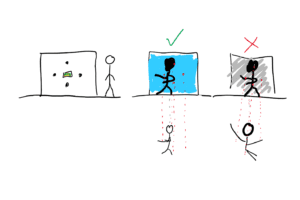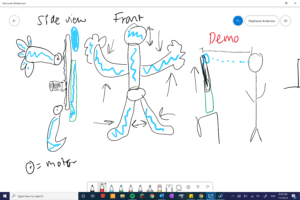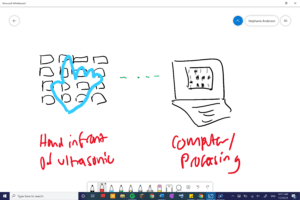Final Project Proposal Interaction Lab
1. Proposal 1: Training a New Master Element Bender
a. I, along with many others, have always had the desire to bend the elements to my will. My first proposal will consist of a project that allows me to do that. It would have 5 sensors: a color sensor in the middle to detect the color of the clothing you are wearing (this will determine what element you will be bending), and four ultrasonic sensors arranged in a diamond in front of you to understand your movements. Projected on a screen in front of you will be a silhouette that you are to mirror in order to conduct your training. The sensors will be able to detect your movements as you cross the thresholds of the sensors and thus know if you are attempting to mimic the movements. The background could be the generic color of the element. For example, blue for water, white for air, red for fire, and green for earth. If your movements are incorrect or too slow, then the background could be changed to a dark color to signal for you to get back on track.
b. Even though I have wanted to do create something like this for a while, looking at interactive displays such as the University of Dayton Interactive Wall has given me some inspiration for how it should look. With their wall, they have a massive screen of LEDs. I will not have that many LEDs at my disposal, but I am confident that I could mimic this effect with ultrasonic sensors and a projector. This project could be used for a range of ages depending on what I display on the screen. For example, if I display a recording of the figure doing the techniques for each type of bending, then this would probably be more interesting for a younger person. This idea could also be used as a program to help elderly people get active. If there was a person on the projector doing basic exercises, the person could stand up (or if they are unable then they can remain sitting and participate with their arms). Of course, a person could equally look on Youtube to try and copy the movements, but this creates an interactive version that keeps you accountable when training.
c. Sources: https://medium.com/mouth-watering-media/the-top-10-digital-interactive-display-walls-40b96066477c
d. Rough schematic of the project design:

2. Proposal 2: Mini-Me
a. This project will create an interactive mirror. Essentially there will be a piece of mirror that will be on an adjusting pole that will grow taller or shorter depending on your height. After that, this figure will have arms and legs that will follow the movement of your arms and legs as you are. There will be four motors. One to raise the neck taller or shorter depending on the person’s height, the second and third one will be to rotate the arms of the person, and the fourth and fifth motors will be to rotate the legs of the figure. Processing will be incorporated by having a display that let you know how close to get to effectively use the mirror. For example, if you are too far away, then the display will be red and there will be a circle that will grow in size as you move closer. When you are at the prime spot, the background will turn green and then arms and neck will adjust.
b. The purpose of the project is to create an interactive mirror that adjusts to you. For people who live alone, this device could be useful, in the way that it acts almost like another person in the room with them. My inspiration for this project was draw from looking at pictures of previous IMA student’s projects on the IMA website. There was a project that looked like a teddy bear with movable arms. There was not a video, so I am unclear as to what the function of the device is, but I liked the concept of creating a movable figure.
c. Sources (inspiration, Image 40/50): https://ima.shanghai.nyu.edu/en/gallery/spring-2017-ima-show
d. Rough schematic of the design:

3. Proposal 3: Interactive art Display
a. For this project, I am thinking about having a 4 by 4 grid of ultra sonic sensors. The purpose of this is to create a field that would allow me to take the distances of the objects or the hand of the user and output it into Processing. The output in processing would be fluidly interactive and would instantly update at your hand or the object in front of the sensors move.
b. This project could be designed like a puzzle which could be used like a password. Let’s say this device is actually a lock on a box and in order to unlock the box you must place a figure or your hand in a specific area in order to make the sensors read values within an acceptable range. Almost like how a face scanner senses your face, this device will be used to sense objects in space. On processing, it will show the values in grayscale how how far or close each sensor is reading. If you are farther away, then it will produce a lighter grayscale; vice versa, being closer to the sensor will produce a darker gray. When the correct code of colors is reached, meaning that the box is unlocked, then the display will turn gray and the box will in tern unlock.
c. I think this project would pose a unique and fun take on a lock that could also be used a puzzle or developed into an app for people who enjoy cognitive puzzles.
d. Inspiration: https://www.youtube.com/watch?v=ikD_3Vemkf0&feature=emb_title
i. This project does not have the idea that I had about incorporating processing to make this a game/ lock and only tracks the location of the figure’s hand. It also does not use ultrasonic sensors.
d. Rough Schematic of the Design:
